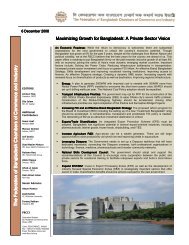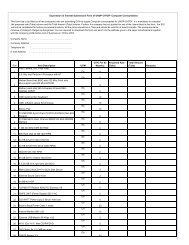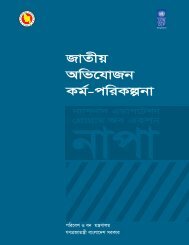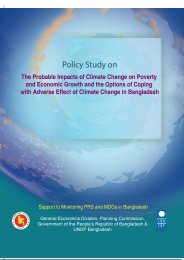Framework for a Strategy of UP Revenue/Resource Mobilisation ...
Framework for a Strategy of UP Revenue/Resource Mobilisation ...
Framework for a Strategy of UP Revenue/Resource Mobilisation ...
Create successful ePaper yourself
Turn your PDF publications into a flip-book with our unique Google optimized e-Paper software.
equire a separate exercise to check against the assessment register to identify who had not paid. In<br />
practice, lists <strong>of</strong> defaulters are not produced <strong>for</strong> purposes <strong>of</strong> follow-up, and there is no record <strong>of</strong><br />
arrears. Although claims are made about follow-up action, it is doubtful if this really happens.<br />
Collection rates are generally very low. It is likely that in most <strong>UP</strong>s, only 5% to 20% <strong>of</strong> households<br />
are paying. This is generally explained in terms <strong>of</strong> people being poor, problems <strong>of</strong> floods, and<br />
reluctance <strong>of</strong> elected Chairmen to take unpopular en<strong>for</strong>cement action. A few places have managed<br />
to increase collection rates significantly. It is observed that collection rates <strong>for</strong> <strong>UP</strong>s in Sirajganj<br />
district as a percentage <strong>of</strong> budgeted revenue, ranging from 1% to 91%. However, budgeted figures<br />
may not reflect the full potential revenue (especially if arrears are not included), so these figures<br />
may overstate the per<strong>for</strong>mance. Moreover, a significant proportion <strong>of</strong> the revenue may be paid by a<br />
few business or institutional payers. For example, one <strong>UP</strong> visited (Gopaya in Narshingdi district)<br />
had managed to collect around half <strong>of</strong> amount holding tax due in 2007/08, but 70% came from just<br />
five institutional payers. The remaining 30% came from 580 other payers (17% <strong>of</strong> households),<br />
while 83% <strong>of</strong> households paid nothing. In another <strong>UP</strong> (Nurpur), receipts were issued to 400<br />
households (12% <strong>of</strong> the total number <strong>of</strong> households), and money received amounted to 18% <strong>of</strong> the<br />
total assessment.<br />
V. Improving <strong>UP</strong> Assessment System, Administration and Collection Procedure<br />
a. Holding Tax Assessment by Improved Method <strong>of</strong> Mass-Appraisal System<br />
What is proposed <strong>for</strong> piloting in some <strong>UP</strong>s is a simpler and more transparent assessment system,<br />
commonly known as mass appraisal. 11 . A simple table is provided in the following showing house<br />
construction types and numbers <strong>of</strong> rooms (construction type will need to be defined precisely<br />
enough so as to minimize scope <strong>for</strong> manipulation). From that, it is very easy to assess a particular<br />
house. It uses five grades <strong>of</strong> construction and up to four rooms. For houses with more than four<br />
rooms, a rate per sq ft can be used. It includes one category <strong>of</strong> shop (up to 100 sq ft), being the most<br />
common type <strong>of</strong> non-residential property in <strong>UP</strong>s. The assessment figure might be increased by<br />
10%. (private water supply and toilets would not be included in the assessment) where <strong>UP</strong> provided<br />
water supply (tube well or piped) is available on the plot,<br />
11 See Nick Devas (July 2007): Local <strong>Revenue</strong> Sources <strong>for</strong> Union Parishads: Report <strong>of</strong> a Study; and Nick Devas<br />
(September 2008): Enhancing <strong>Revenue</strong> Sources <strong>for</strong> Union Parishads<br />
11










